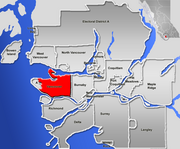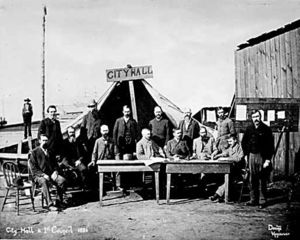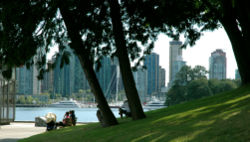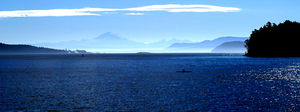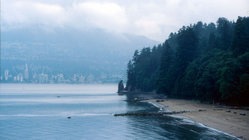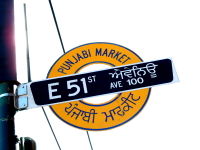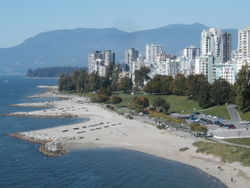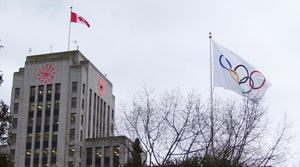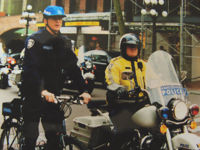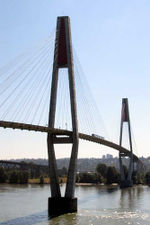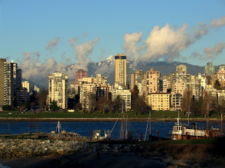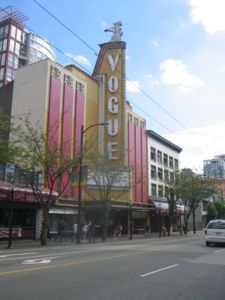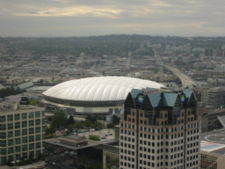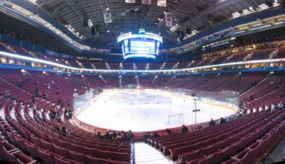Vancouver
2007 Schools Wikipedia Selection. Related subjects: North American Geography
| Vancouver | |
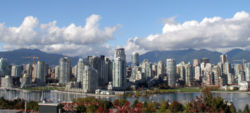 Downtown Vancouver as seen from Fairview Slopes north across False Creek. |
|
 ( Coat of Arms of Vancouver) |
 ( Flag of Vancouver) |
|
|
|
| Area | 114.67 km² |
| Metro area | 2,878.52 km² |
| Population | 583,267 (2005 est.) |
| Pop'n rank | 8th |
| Metro pop'n | 2,208,300 (2005 est.) |
| Metro rank | 3rd |
| Pop'n density | 5252/km² |
| Location | 49°16' N 123°7' W |
| Altitude | Sea level to 167 metres |
| Incorporation | 1886 |
| Province | British Columbia |
| Regional District | Greater Vancouver |
| Members of Parliament | Libby Davies, Ujjal Dosanjh, David Emerson, Hedy Fry, Stephen Owen |
| Members of the Legislative Assembly | Gordon Campbell, David Chudnovsky, Adrian Dix, Colin Hansen, Jenny Kwan, Lorne Mayencourt, Wally Oppal, Gregor Robertson, Shane Simpson, Carole Taylor |
| Mayor | Sam Sullivan |
| City Manager | Judy Rogers |
| Governing Body | Vancouver City Council |
| Time zone | Pacific (UTC-8) |
| Postal code | V5K to V6Z |
| Area Code | 604, 778 |
| Official website: City of Vancouver | |
Vancouver ( pronounced: [vænˈkuːvɚ]) is a city in southwestern British Columbia, Canada. The city is named after Captain George Vancouver, an English explorer. A resident of Vancouver is called a "Vancouverite." Vancouver is part of the Greater Vancouver Regional District metropolitan area. With a population of 2,208,300 (2005 estimate), it is the largest metropolitan area in western Canada and the third largest in the country. The population of Vancouver proper is 583,267. Vancouver has a very ethnically diverse population: more than half of its residents have a mother tongue other than English. The city is growing rapidly, and the metropolitan population is projected to reach 2.6 million by 2020.
Vancouver is located between the Strait of Georgia and the Coast Mountains. Its economy has traditionally relied on British Columbia's resource sectors: forestry, mining, fishing and agriculture. It was first settled in the 1860s as a result of immigration caused by the Fraser Canyon Gold Rush, and developed rapidly from a small lumber mill town into a metropolitan centre following the arrival of the transcontinental railway in 1887. The Port of Vancouver became internationally significant after the completion of the Panama Canal and reduced freight rates in the 1920s made it viable to ship export-bound prairie grain west through Vancouver. It has since become the busiest seaport in Canada and exports more cargo than any other port in North America. The economy of Vancouver has become more diverse over time, however. Vancouver has a growing tourism industry, for example, and has become the third largest film production centre in North America, after Los Angeles and New York.
Vancouver is consistently ranked one of the three most livable cities in the world. In 2006, the city was ranked the 56th most expensive city to live in among 144 major cities in the world and the second most expensive in Canada (after Toronto).
The 2010 Winter Olympics will be held in Vancouver and nearby Whistler.
Origins of the city
Archaeological records indicate that the presence of Aboriginal peoples ( Sto:lo) in the Vancouver area dates back 4,500-9,000 years. The coastline of present day Point Grey was first explored in 1791 by José María Narváez of Spain, followed by George Vancouver, who also explored the inner harbour of Burrard Inlet in 1792 and gave various places British names.
In 1808, Simon Fraser arrived in what is now Marpole. He was searching for the Columbia River, but soon discovered that he was not in the Columbia and was taken captive by natives. The river he did search was later renamed after him. The gold rush of brought 25,000 men, mainly from California, to the Fraser River and what would become Vancouver. The first pillar of the local economy was the Hastings Mill, a sawmill at the foot of Gore Street around which the nucleus of what became Vancouver formed. The mill's central role in the city waned after the arrival of the Canadian Pacific Railway (CPR), but it nonetheless remained important to the local economy until it closed in the 1920s. Vancouver is among British Columbia's youngest cities. In 1870, the settlement was officially known as "Granville Townsite." Fourteen years later, the settlement was officially named after Captain Vancouver by William Van Horne, who arrived in Port Moody to establish the CPR terminus. A massive "slash burn" (clearing fire) broke out on June 13, 1886, razing the entire city. It was quickly rebuilt, and the Vancouver Fire Department was established that same year. From a settlement of 1,000 people in 1881, Vancouver's population grew to over 20,000 by the turn of the century and 100,000 by 1911.
During the 1898 Klondike gold rush, Vancouver merchants sold a great deal of equipment to prospectors. One of those merchants, Charles Woodward, had opened the first Woodward's store at what is now Georgia and Main Streets in 1892 and, along with Spencer's and the Hudson's Bay Company department stores, formed the dominant core of the city's retail sector for decades.
The economy of early Vancouver was dominated by large companies such as the CPR, which had the capital needed for the rapid development of the new city. Some manufacturing did develop, but the resource sector was the backbone of Vancouver's economy, initially with logging, and later with exports moved through the seaport, where commercial traffic constituted the largest economic sector in Vancouver by the 1930s.
The economic dominance of big business was accompanied by an often militant labour movement. The first major sympathy strike was in 1903 when railway employees struck against the CPR for union recognition. Labour leader Frank Rogers was killed while picketing at the docks by CPR police during that strike, becoming the British Columbia movement's first martyr. Canada's first general strike occurred following the death of another labour leader, Ginger Goodwin, in 1918, at the Cumberland coal mines on Vancouver Island. A lull in industrial tensions through the later 1920s came to an abrupt end with the depression. Most of the 1930s strikes were led by Communist Party organizers. That strike wave peaked in 1935 when unemployed men flooded the city to protest conditions in the relief camps run by the military in remote areas throughout the province. After two tense months of daily and disruptive protesting, the relief camp strikers decided to take their grievances to the federal government and embarked on the On-to-Ottawa Trek.
Other social movements, such as the first-wave feminist, moral reform, and temperance movements were also influential in Vancouver's development. Mary Ellen Smith, a Vancouver suffragist and prohibitionist, became the first woman elected to a provincial legislature in Canada in 1918. Alcohol prohibition began in the First World War and lasted until 1921, when the provincial government established its control over alcohol sales, which still persists today. Canada's first drug law came about following an inquiry conducted by the federal minister of labour and future prime minister, William Lyon Mackenzie King. King was sent to investigate damages claims resulting from a riot when the Asiatic Exclusion League led a rampage through Chinatown and Japantown. Two of the claimants were opium manufacturers, and after further investigation, King found that white women were reportedly frequenting opium dens as well as Chinese men. A federal law banning the manufacture, sale, and importation of opium for non-medicinal purposes was soon passed based on these revelations.
Amalgamation with Point Grey and South Vancouver gave the city its final contours not long before taking its place as the third largest metropolis in the country. As of January 1st, 1929, the population of the enlarged Vancouver was 228,193 and it filled the entire peninsula between the Burrard Inlet and the Fraser River.
Geography
The original vegetation of most of Vancouver and its suburbs was dense temperate rain forest, consisting of conifers with scattered pockets of maple and alder, as well as large areas of swampland (even in upland areas, due to poor drainage).
The conifers were a typical coastal British Columbia mix of Sitka spruce, Western red cedar, Western hemlock, Douglas fir, and yew and are thought to have been the greatest concentration of the largest of these trees on the entire British Columbia Coast. Only in Seattle's Elliott Bay did the trees rival those of Burrard Inlet and English Bay in size. The largest trees in Vancouver's old-growth forest were in the Gastown area, where the first logging occurred, and on the south slopes of False Creek and English Bay, especially around Jericho Beach. The forest in Stanley Park is mostly second and third growth and evidence of old-fashioned logging techniques such as springboard notches can still be seen there.
A diverse collection of plants and trees were imported from other parts of the continent and from points across the Pacific, and can be found growing throughout Vancouver and the Lower Mainland. Various species of palm trees have proven hardy in this climate and are a common sight, as are large numbers of other exotic trees such as the monkey puzzle tree, the Japanese maple, and various flowering exotics such as magnolias, azaleas, and rhododendrons. Many rhododendrons have grown to immense sizes, as have other species imported from harsher climates in Eastern Canada or Europe. The native Douglas Maple can also attain a tremendous size. Many streets in the city are lined with flowering varieties of Japanese cherry trees that were donated by Japan, starting in the 1930s. Certain areas of West Vancouver that have the right soil requirements are home to the Arbutus menziesii tree.
Vancouver has an area of 114 km² (44 sq miles), including both flat and hilly ground. Vancouver is adjacent to the Strait of Georgia, a body of water that is shielded from the Pacific Ocean by Vancouver Island. It is in the Pacific Time Zone (UTC-8) and the Pacific Maritime Ecozone. The city itself forms part of the Burrard Peninsula, lying between Burrard Inlet to the north and the Fraser River to the south. Vancouver is not on nearby Vancouver Island. However, both the island and the city (as well as Vancouver, Washington) are named after Royal Navy Captain George Vancouver.
Vancouver is renowned for its scenery and has one of the largest urban parks in North America, Stanley Park. The North Shore Mountains dominate the cityscape and on a clear day scenic vistas include the snow-capped volcano Mount Baker in the State of Washington to the southeast, Vancouver Island across the Strait of Georgia to the west and southwest, and the Sunshine Coast to the northwest.
Vancouver's climate is unusually temperate by Canadian standards; its winters are the fourth warmest of Canadian cities monitored by Environment Canada after nearby Victoria, Nanaimo, and Duncan, all of which are on Vancouver Island. Vancouver has daily minimum temperatures falling below 0°C (32°F) on an average of 46 days per year and below -10°C (14°F) on only two days per year. The average annual precipitation is about 1,219 mm (48 in), though this varies dramatically throughout the city due to the topography. Summer months are quite sunny with moderate temperatures. The daily maximum averages 22°C (72°F) in July and August, although temperatures sometimes rise above 26°C (78°F). The summer months are often very dry, resulting in moderate drought conditions a few months of the year. In contrast, more than half of all winter days receive measureable precipitation. On average, snow falls on only eleven days per year, with only three days receiving six or more centimetres.
The air quality in the city has been deteriorating for several decades because of the increasing number of cars in the area. Smog can be seen year round. The number of cars is growing at almost twice the rate of the human population, resulting in increased congestion and pollution. Some actions have be taken by various levels of government to limit the problem, such as reducing automobile emissions by vehicle emissions testing. Air quality in the Fraser Valley often suffers as Vancouver's pollution is blown in that direction and "boxed in" by the mountains.
Demographics
City planners in the late 1950s and 1960s deliberately encouraged the development of high-rise residential towers in Vancouver's West End of downtown, resulting in a compact urban core amenable to public transit, cycling, and pedestrian traffic. Vancouver's population density on the downtown peninsula is 121 people per hectare (or 49 people per acre [2001 census]). The city continues to pursue policies intended to increase density as an alternative to sprawl, such as Mayor Sullivan's EcoDensity — an initiative to create quality and high density areas in the city, while making property ownership more economical. The plan also calls for the increased construction of community centres, parks, and cultural facilities.
Vancouver has been called a "city of neighbourhoods," each with a distinct character and ethnic mix. People of British origin were historically the largest ethnic group in the city, and notably the majority of Vancouverites of British ancestry have direct family links to the British Isles rather than to other parts of Canada, and elements of British society and culture are highly visible in some areas, particularly South Granville and Kerrisdale. The Chinese are by far the largest visible ethnic group in the city, and Vancouver has one of the most diverse Chinese-speaking communities, with several Chinese languages being represented. There are also many monocultural neighbourhoods, such as the Punjabi Market, Little Italy (roughly synonymous with Commercial Drive but also including the Nanaimo and Hastings area), Greektown, and Japantown. Bilingual street signs can be seen in various neighbourhoods, including Chinatown and the Punjabi Market.
Many immigrants from Hong Kong made Vancouver their home following the transfer of that former colony's sovereignty from the United Kingdom to China. This continued a tradition of immigration from around the world that had already established Vancouver as the second most popular destination for immigrants in Canada (after Toronto). Other significant Asian ethnic groups in Vancouver are South Asians (mostly Punjabis, usually referred to as Indo-Canadians), Vietnamese, Filipino, Korean, Cambodian, and Japanese.
Prior to the Hong Kong influx of the 1980s, the largest non-British ethnic group in the city was German, followed by Ukrainian, Scandinavian, Italians and the historical Chinese population. Invisible minorities, such as newly-arrived Eastern Europeans, are also a feature of the city's ethnic landscape.
There is also a sizable aboriginal community in Vancouver as well as in the surrounding metropolitan region, with the result that Vancouver constitutes the largest native community in the province.
While not completely free of racial tension, Vancouver has relatively harmonious race relations. One result is a relatively high rate of intermarriage; mixed ethnicity couples are unremarkable in any neighbourhood. Both the annual Dragon Boat Festival and Lunar New Year's Day Parade are well attended by residents of all ethnic backgrounds.
Vancouver has one of the largest gay communities in North America and British Columbia was the second Canadian jurisdiction to declare that gay marriage is a constitutional right, after Ontario. The downtown area around Davie Street is home to most of the city's gay clubs and bars and is known as Davie Village. Every year Vancouver holds one of the country's largest gay pride parades.
Economy
With its location on the Pacific Rim and at the western terminus of Canada's transcontinental highway and rail routes, Vancouver is one of the nation's largest industrial centres.
The Port of Vancouver, Canada's largest and most diversified, does more than $43 billion in trade with over 90 countries annually. Port activities generate $4 billion in gross domestic product and $8.9 billion in economic output. Vancouver is also the headquarters of forest product and mining companies. In recent years, Vancouver has become an increasingly important centre for software development, biotechnology and a vibrant film industry.
The city’s scenic location makes it a major tourist destination. Visitors come for the city’s gardens, Stanley Park, Queen Elizabeth Park, and a combination of mountains, ocean, forest and parklands surrounding the city. The numerous beaches, parks, waterfronts, and mountain backdrop, combined with its cultural and multi-ethnic character, all contribute to its unique appeal and style for tourists. Over a million people annually pass through Vancouver en route to a cruise ship vacation, usually to Alaska.
The city's popularity comes with a price. Vancouver can be an expensive city, with the highest housing prices in Canada. Several 2006 studies rank Vancouver as having the least affordable housing in Canada, one ranking it fifteenth least affordable in the world, marginally more affordable than London. The city has adopted various strategies to reduce housing costs, including cooperative housing, legalized secondary suites, increased density and smart growth. The city’s residents are generally affluent, a perception reinforced by the number of luxury vehicles on city streets and cost of real estate. The average home in Vancouver sells for $548,022, compared to $374,067 in Calgary, the next most expensive major city in Canada.
A major and ongoing downtown condominium construction boom began in the late 1990s, financed in large part by a huge flow of capital from Hong Kong immigrants prior to the 1997 hand-over to China. High-rise residential developments from this period now dominate the Yaletown and Coal Harbour districts of the downtown peninsula, and also cluster around some of the SkyTrain stations on the east side of the city.
The city has been selected to co-host the 2010 Winter Olympics, which is influencing economic development. Concern has been expressed that Vancouver’s increasing homelessness problem may be exacerbated by the Olympics because owners of single room occupancy hotels, which house many of the city’s lowest income residents, have begun converting their properties in order to attract higher income residents and tourists. Another significant international event, the 1986 World Exposition, was held in Vancouver. It was the last World's Fair held in North America and was considered a success, receiving 20,111,578 visits. Several Vancouver landmarks date from that period, including the SkyTrain public transit system, the Plaza of Nations, and Canada Place.
Governance
The civic government has been dominated by the right wing Non-Partisan Association (NPA) since the Second World War, albeit with some significant centre-left interludes. The NPA’s Sam Sullivan was elected mayor of Vancouver in November 2005, signaling the party’s return to power after a social democratic slate swept the previous election. The NPA fractured over the issue of drug policy in 2002, facilitating a landslide victory for the Coalition of Progressive Electors on a harm reduction platform. Subsequently, North America’s first safe injection site was opened for the significant number of intravenous heroin users in the city.
Vancouver is governed by the ten-member Vancouver City Council, a nine-member School Board, and a seven-member Parks Board, all elected for three year terms through an at-large system. Historically, in all levels of government, the more affluent west side of Vancouver has voted along conservative or centre-right lines while the eastern side of the city has voted along left-wing lines. This was reaffirmed with the results of the 2005 provincial election.
Though polarized, a political consensus has emerged in Vancouver around a number of issues. Protection of urban parks, a focus on the development of rapid transit as opposed to a freeway system, a harm reduction approach to illegal drug use, and a general concern about community based development are examples of policies that have come to have broad support across the political spectrum in Vancouver.
In the 2005 Municipal Election elections, City Council swung back to the right after a term dominated by the leftist Coalition of Progressive Electors (COPE). NPA mayoral candidate Sam Sullivan narrowly defeated Jim Green for the position of mayor and was joined by five of his party's members on Council. The centrist Vision Vancouver (VVN) brought four members to Council with the final seat going to COPE. The NPA also won six of nine School Board seats and five of seven Parks Board seats, while the remaining Board seats were won by COPE. Former Mayor Larry Campbell chose not to run for re-election and was subsequently appointed to the Senate of Canada.
In the Legislative Assembly of British Columbia, Vancouver is represented by ten Members of the Legislative Assembly (MLAs). In the 2005 provincial election, the BC Liberal Party and the BC New Democratic Party each won five seats.
In the Canadian House of Commons, Vancouver is represented by five Members of Parliament. In the 2004 federal elections, the Liberal Party of Canada won four seats and the federal New Democratic Party (NDP) one. In the 2006 federal elections, all the same Members of Parliament were re-elected. However, on February 6, 2006, David Emerson of Vancouver Kingsway defected to the Conservative Party, giving the Conservatives one seat in Vancouver. As of February 2006, the Liberals hold three seats, and the NDP and the Conservatives hold one each.
The former mayor, Larry Campbell, came to office in 2002 in part because of his willingness to champion alternative interventions for drug issues, such as supervised injection sites. The city has adopted a Four Pillars Drug Strategy, which combines harm reduction (e.g. needle exchanges, supervised injection sites) with treatment, enforcement, and prevention. The strategy is largely a response to the endemic HIV and hepatitis C among injection drug users in the city's Downtown Eastside neighbourhood. The area is characterized by entrenched poverty and consequently is home to the "low track" street sex trade and a bustling "open air" street drug market, which gave rise to a significant AIDS epidemic in the 1990s. Some community and professional groups — such as From Grief to Action and Keeping the Door Open. — are fostering public dialogue in the city about further alternatives to current drug policies.
While most of the Lower Mainland is policed by the RCMP's "E" Division, Vancouver has its own city police force (as do New Westminster, West Vancouver, Delta, and Port Moody), with a strength of 1,174 sworn members and an operating budget of almost $150 million (in 2005 figures). Over 16% of the city's budget was spent on police protection in 2005.
The Vancouver Police has numerous operational divisions, including a bicycle squad, a marine squad, and a dog squad. It also has a mounted squad, used primarily to patrol Stanley Park and occasionally the Downtown Eastside and West End, as well as for crowd control. The police work in conjunction with civilian and volunteer run Community Police Centres. In 2006, the police department established its own Counter Terrorism Unit, which led to speculation of a rift between the Vancouver Police and the Royal Canadian Mounted Police because the latter normally handles national security matters. In 2005, a new transit police force, the Greater Vancouver Transportation Authority Police Service (GVTAPS), was established with full police powers.
Although it is technically illegal, Vancouver police generally do not arrest people for possessing small amounts of marijuana. In 2000 the Vancouver Police Department established a specialized drug squad, "Growbusters," to carry out an aggressive campaign against the city's estimated 4,000 hydroponic marijuana growing operations (or grow-ops) in residential areas. As with other law enforcement campaigns targeting marijuana this initiative has been sharply criticized.
As of 2005, Vancouver (CMA) had the fourth highest crime rate among all Canadian cities. However, as with other Canadian cities, the over-all crime rate has been falling "dramatically." Vancouver's property-crime rate is particularly high, ranking among the highest for major North American cities. But even property crime dropped 10.5% between 2004 and 2005, according the Vancouver Police."
Transportation
Vancouver's streetcar system began on June 28th, 1890 and ran from the (first) Granville Street Bridge to Westminster Avenue (now Main Street). Less than a year later, the Westminster and Vancouver Tramway Company began operating Canada's first interurban line between the two cities, which encouraged residential neighbourhoods outside the central core to develop. The British Columbia Electric Railway, became the company that operated the urban and interurban rail system until 1958 when its last vestiges were dismantled in favour of diesel buses.
City councils, as part of a long term plan, prohibited the construction of freeways in the 1980s. The only major freeway within city limits is Highway 1, which passes through the eastern edge of the city.
TransLink, the Greater Vancouver Regional District transportation authority, is responsible for roads and public transportation within region. It provides a bus service, B-Line Rapid Bus Service (2 of the 3 B-Lines run in Vancouver with 2 more B-Line's by 2008), a foot passenger and bicycle ferry service (known as SeaBus), a two-line automated metro system called SkyTrain, and the commuter rail West Coast Express. Future projects include the Canada Line, a metro style train line that will connect Vancouver International Airport and the neighbouring municipality Richmond with Downtown.
Inter-city passenger rail service is operated from Pacific Central Station by VIA Rail to points east; Amtrak Cascades to Seattle, Washington; and Rocky Mountaineer rail tour routes.
Vancouver is served by Vancouver International Airport (YVR), located on Sea Island in the City of Richmond, immediately south of Vancouver. Vancouver's airport is Canada's second busiest airport, and the second largest gateway on the west coast of North America for international passengers. HeliJet and two float plane companies operate scheduled air service from Vancouver harbour. The city is also served by two BC Ferry terminals. One is to the northwest at Horseshoe Bay, West Vancouver, and the other is to the south, at Tsawwassen (in Delta).
Education
Vancouver is served by School District 39 Vancouver, the second largest school district in British Columbia. As in other parts of the province, numerous independent schools are also eligible for partial provincial funding — this includes religious schools, non-denominational schools, and special-needs schools, nearly all of which also charge tuition. Vancouver also includes several elementary and secondary schools that are part of the province-wide Conseil Scolaire Francophone (CSF), the francophone public school district.
Vancouver is served by the Lower Mainland's two major public universities, the University of British Columbia (UBC) and Simon Fraser University (SFU), as well as one major private university, Trinity Western University (TWU). UBC and SFU have satellite campuses within the city, as does the British Columbia Institute of Technology, which provides polytechnic education and grants degrees in several fields. Vancouver Community College and Langara College, along with other colleges in surrounding communities, provide career, trade, and university-transfer programs for Vancouver residents. Emily Carr Institute of Art and Design grants certificates, diplomas, and degrees in art and design.
Architecture and cityscape
Notable buildings within the city include Christ Church Cathedral, the Hotel Vancouver, the Museum of Anthropology ( Arthur Erickson, architect) at the University of British Columbia, and the Vancouver Art Gallery. There are several striking modern buildings in the downtown area, including the Vancouver Law Courts and surrounding plaza known as Robson Square ( Arthur Erickson) and the Vancouver Library Square ( Moshe Safdie, architect), reminiscent of the Colosseum in Rome.
The original BC Hydro headquarters building at Nelson and Burrard Streets is a modernist high-rise, now converted into the Electra condominiums. Also notable is the "concrete waffle" of the MacMillan-Bloedel building on the north-east corner of the Georgia and Thurlow intersection. A prominent addition to the city's landscape is the giant tent-frame Canada Place, the former Canada Pavilion from Expo '86, which includes the Trade and Convention Centre as well as a Cruise Ship Terminal and the Pan-Pacific Hotel. Two modern skyscrapers that define the skyline looking south are the city hall and the Centennial Pavilion of Vancouver Hospital, both by Townley and Matheson (1936 and 1958 respectively).
A collection of Edwardian buildings in the city's old downtown core were, in their day, the tallest buildings in the British Empire. These were, in succession, the Province Building, the Dominion Building (1907, both at Cambie and Hastings Streets), and the Sun Tower (1911) at Beatty and Pender Streets. The Sun Tower's cupola was finally exceeded as the Empire's tallest by the elaborate Art Deco Marine Building in the 1920s. Inspired by New York's Chrysler Building, the Marine Building is known for its elaborate ceramic tile facings and brass-gilt doors and elevators, which make it a favourite location for movie shoots. Another notable Edwardian building in the city is the Vancouver Art Gallery building, designed by Francis Mawson Rattenbury, who also designed the provincial Legislature and the original and highly decorative Hotel Vancouver (torn down after WWII as a condition of the completion of the new Hotel Vancouver a block away).
Topping the list of tallest buildings in Vancouver as of June 2006 is One Wall Centre at 150 m and 48 storeys, followed closely by the Shaw Tower at 149 m and 41 storeys.
Vancouver's "View Protection Guidelines" were approved in 1989 and amended in 1990, establishing view corridors in the downtown with height limits to protect views of the North Shore Mountains. These guidelines have succeeded in preserving mountain views, although some find Vancouver's skyline flat and lacking in visual interest. Many agree that there is a need for some taller buildings to reflect Vancouver's contemporary image, but others are concerned about proposals for much higher buildings. Many believe that the natural setting, and in particular, views of the North Shore Mountains, may be hindered as tall buildings grow in number. In response to these concerns, Council commissioned a "Skyline Study" in 1997.
The Skyline Study concluded that Vancouver's skyline would benefit from the addition of a handful of buildings exceeding current height limits, to add visual interest to Vancouver's skyline. This led to the General Policy on Higher Buildings. The study noted that the opportunities for such buildings were restricted due to a limited number of large development sites in the downtown. There were at least five sites identified where buildings exceeding the 450 foot height limit are possible and at least two sites in the northwest corner of the central business district where heights up to 400 feet (exceeding the 300 foot limit) might be considered. Eight years later, five of the seven identified sites for higher buildings have been developed or are in the development application process. The tallest of these new buildings is the Living Shangri-La hotel/residential tower, which when completed in 2007 will stand 197 m tall (61 storeys).
Arts and culture
Prominent theatre companies in Vancouver include the Arts Club Theatre Company, the Vancouver Playhouse Theatre Company, and Bard on the Beach. Smaller companies include Touchstone Theatre, Studio 58, Carousel Theatre, and the United Players of Vancouver. Theatre Under the Stars produces shows in the summer at Malkin Bowl in Stanley Park. In addition, Vancouver holds an annual Fringe Festival and International Film Festival.
Vancouver is the home to a number of museums and galleries. The Vancouver Art Gallery has a permanent collection of over 7,900 items valued at over $100 million and is the home of a significant number of works by Emily Carr. The Vancouver Maritime Museum is a nautical museum with the St. Roch, an historic arctic exploration ship, as its centrepiece. The Museum of Anthropology at UBC is a leading museum of Pacific Northwest Coast First Nations culture and the Vancouver Museum is the largest civic museum in Canada. A more interactive museums is Science World.
In 1986, Greater Vancouver’s cultural community created the Alliance for Arts and Culture to provide a strong voice for the sector and an avenue to work together. This coalition now numbers more than 320 arts groups and individuals. The Alliance's mission is to, "strive towards an environment that recognizes, respects, and responds to the contribution our sector makes to society’s well-being."
Vancouver is a major regional centre for the development of Canadian music. The city's musical contributions include performers of classical, folk and popular music.
The city played an important role in the development of punk rock, perhaps most famously including the band D.O.A., Nomeansno, and the industrial group Skinny Puppy. Other Vancouver bands who achieved stardom in London during the punk era were The Pointed Sticks, I, Braineater, U-J3RK5 (pronounced "you jerk": the five is silent), the Young Canadians (originally the K-Tels) and The Modernettes. Vancouver was also where the punk movie "Terminal City Ricochet" was filmed; the movie's name comes from a hockey team called the Terminal City Ricochets.
Mainstream pop music has featured bands and performers such as Prism, Trooper, Chilliwack, Econoline Crush, and Bryan Adams. Some music stars whose names were made abroad have chosen Vancouver as their residence, including Sarah McLachlan, Jerry Doucette, Koko Taylor, Jim Byrnes and others.
Larger performances are usually held at venues such as GM Place, Queen Elizabeth Theatre, BC Place Stadium or the Pacific Coliseum, while smaller acts are held at places such as the Plaza of Nations, the Commodore Ballroom, the Orpheum Theatre and the Vogue Theatre.
Two significant annual music festivals are held in Vancouver. The Vancouver Folk Music Festival and the Vancouver International Jazz Festival showcase music in their respective genres from around the world.
The CBC Radio Orchestra and the Vancouver Symphony Orchestra are the two professional orchestras based in the city. It is also home to a major opera company, the Vancouver Opera, and numerous regional opera companies throughout the metropolitan area.
Vancouver's large Chinese population has a significant music scene, which has produced several Cantopop stars. Similarly, various Indo-Canadian artists and actors have a profile in Bollywood or other aspects of India's entertainment industry.
Nightlife in Vancouver had, for years, been seen as restricted in comparison to other cities, with early closing times for bars and night clubs, and a reluctance by authorities to allow for further development. However, since 2003 Vancouver has experimented with later closing hours and relaxed regulations, and an effort has been made to develop the Downtown core even further as an entertainment district, especially on and around Granville Street.
Sports and recreation
The mild climate of the city and close proximity to ocean, mountains, rivers and lakes make the area a popular destination for outdoor recreation. Indeed, Vancouver has a low adult obesity rate of 12% compared to the Canadian average, 23%; however, while 51% of Vancouverites are considered overweight, it is the fourth thinnest city in Canada after Toronto, Montreal, and Halifax.
Vancouver has over 1,298 hectares (2,700 acres) of parks, with Stanley Park being the largest at 404 hectares (1,000 acres). The municipality also has several large beaches, many flowing into each other, with the largest groups extending from the coast of Stanley Park before reaching False Creek, and on the other side of English Bay, starting in the Kitsilano neighbourhood all the way to the University Endowment Lands, which are separate from Vancouver. The 18 kilometres (11 miles) of beaches that surround Vancouver include English Bay (First Beach), Jericho, Kitsilano Beach, Locarno, Second Beach (Stanley Park), Spanish Bank East, Spanish Bank Extension, Spanish Bank West, Sunset, and Third Beach (Stanley Park). The coastline provides for many types of water sport, and the city is a popular destination for boating enthusiasts.
The nearby North Shore mountains are home to three ski hills, Cypress Bowl, Grouse Mountain, and Mount Seymour. Each are within 20 to 30 minutes (driving time) of downtown Vancouver. Mountain bikers have created world-renowned trails across the North Shore. The Capilano River, Lynn Creek, Seymour River, are within 20 minutes (driving time) of downtown provide opportunities to white water enthusiasts during periods of rain and spring melt.
Vancouver will be the host city for the 2010 Winter Olympics, and the 2009 World Police and Fire Games. Swangard Stadium, just across the city line in Burnaby, will host some games for the 2007 FIFA U-20 World Cup.
- Professional sports teams
| Club | Sport | League | Venue |
|---|---|---|---|
| Vancouver Canucks | Ice hockey | National Hockey League | General Motors Place |
| British Columbia Lions | Football | Canadian Football League | BC Place Stadium |
| Vancouver Canadians | Baseball (Single A Short Season) | Northwest League | Nat Bailey Stadium |
| Vancouver Giants | Ice hockey (Junior) | Western Hockey League | Pacific Coliseum |
| Whitecaps FC Whitecaps Women |
Soccer | USL First Division (men's) W-League (women's) |
Swangard Stadium |
Affiliated cities and municipalities
The City of Vancouver was one of the first cities in Canada to enter into an international twinning arrangement. The City of Vancouver has created special arrangements for cultural, social and economic benefits with the following cities:
|
|
There are 21 municipalities in the Greater Vancouver Regional District (GVRD). While each of these has a separate municipal government, the GVRD oversees common services within the metropolitan area such as water, sewage, transportation, and regional parks.
 |
West Vancouver | City of North Vancouver | District of North Vancouver |  |
| University Endowment Lands | Burnaby New Westminster |
|||
| Strait of Georgia | Richmond Delta |
Surrey |
